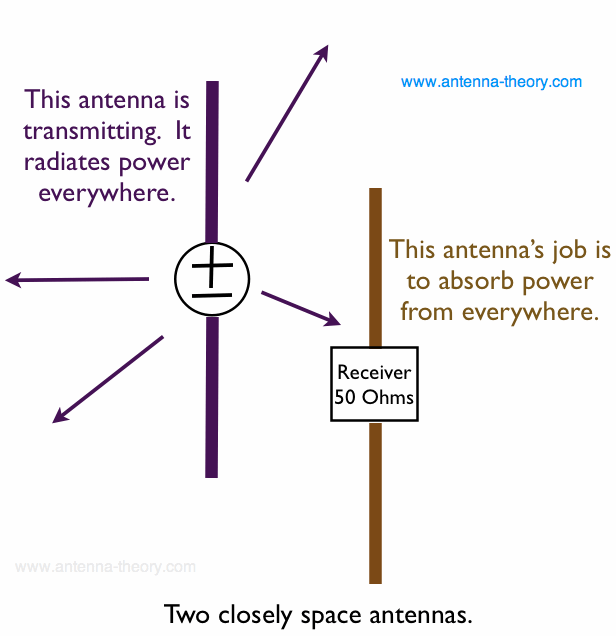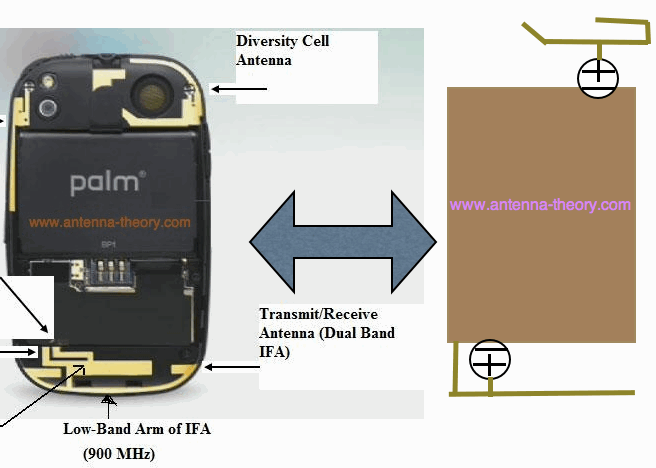Diversity Cell Phone Antenna Design
|
Most modern cell phones have two cellular antennas. We've discussed previously antenna design for the primary cellular antenna. The second cellular antenna is the diversity antenna. This antenna typically does receive only. This means it only needs to cover the Rx frequencies, and not the Tx frequencies for the cellular frequency bands the phone covers. The diversity antenna's job is to try to provide an independent sample of data from the signals in the vicinity of the phone. The mobile phone's receiver then will typically do switched diversity (i.e. choose the receive signal with the most energy) or combined diversity (in order to sum the powers from the two receiving cellular antennas). Given that the cellular antennas require a lot of space (recall we want a half-wavelength at cell frequencies, which is often the whole size of the device), you would be right to note that it will be tough for these two antennas to be independent. That is, they will experience a good amount of mutual coupling. This antenna to antenna coupling can reduce the efficiency of both antennas. This is illustrated in Figure 1. We have two antennas that are closely spaced. The transmitting antenna wants to communicate with an antenna far away, and the receiving antenna is trying to absorb as much energy around it as possible:

Figure 1. Closely Space Antennas Couple Together. The problem in Figure 1 is that some of the energy that would have been radiated away by the transmit antenna is absorbed by the receiver of the closely spaced receive antenna. Any power absorbed by this antenna is a loss in antenna efficiency. The same situation happens in reverse, which means energy that would have been absorbed from the diversity antenna is absorbed by the primary antenna. This negatively affects performance. The goal then is to maximize the isolation between the two antennas. This will minimize the effect of this coupling loss. The coupling loss can be 1-2 dB for antenna efficiency, which is bad. Isolation values for smartphones at the lowband are about 10 dB, and can be 20 dB for the highband. See also antenna isolation and mutual coupling. In order to maximize isolation (and also to make the radiation patterns somewhat distinct), the diversity antenna is typically placed on the top of the smartphone. This is illustrated again on the palm pre smartphone - the diversity antenna is on the top of the device. Note that they maximized the space between the feed points of the primary and diversity antennas:

Figure 2. Diversity Cellular Antenna - Opposite Side of Smartphone from Primary Cell Antenna. The specifications or requirements for the diversity antenna are often given relative to the primary cellular antenna. That is, there often isn't an absolute TIS sensitivity number (as in, the Band 5 TIS must be better than -101 dBm). Instead, the diversity antenna metric is often something like "the diversity TIS must be within 3 dB of the primary cellular antenna TIS". This means that if the primary cell antenna TIS is -104 dBm, then the diversity antenna spec would be -101 dBm for the same band. In addition, just as the primary cell antenna had a "head spec" where the TIS was measured on a mannequin head, the diversity antenna will have the same type of spec or requirement. Note that because the diversity antenna is higher on the phone, it often suffers more "head loss" when the phone is mounted on a head. Fortunately, because the diversity antenna typically does not transmit, there are no TRP or SAR specs to worry about. Currently, advanced modulation schemes (i.e. 4G LTE) do allow for MIMO (multiple input, multiple output) transmission from the mobile to the base station. The idea here is multiple independent data streams to maximize throughput. I don't believe this has been implemented on any phone to date (2013); however it is possible that diversity antennas in the future will allow for transmit power in the future to enable MIMO. In that case, the design of the diversity antenna will still follow the ideas behind the primary cellular antenna design.
|
Antennas (Home)
Why Is The Sky Blue? [Different Site]
|
This page on diversity cellular mobile phone antenna design for smartphones is copyrighted. No portion can be reproduced without permission
from the webmaster. Copyright antenna-theory.com, 2012-2014, diversity antennas.
|
|---|